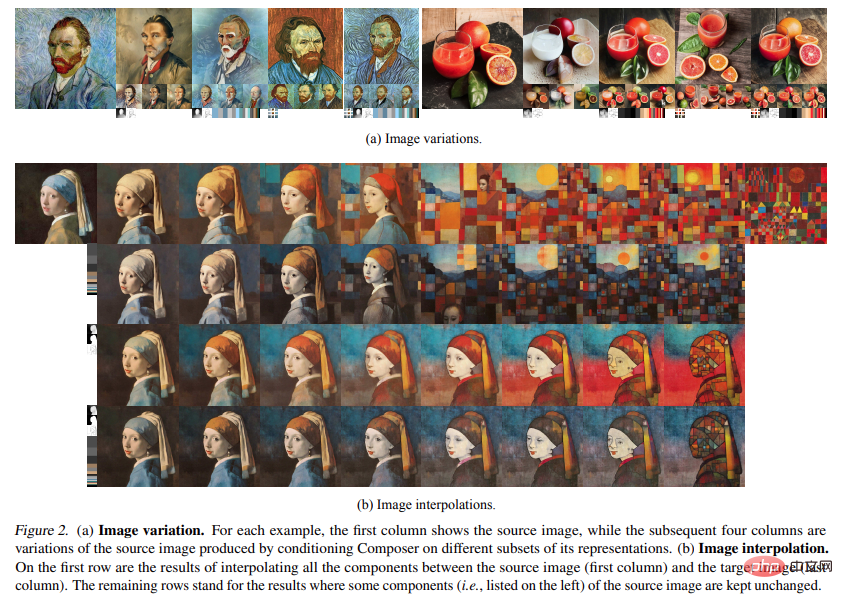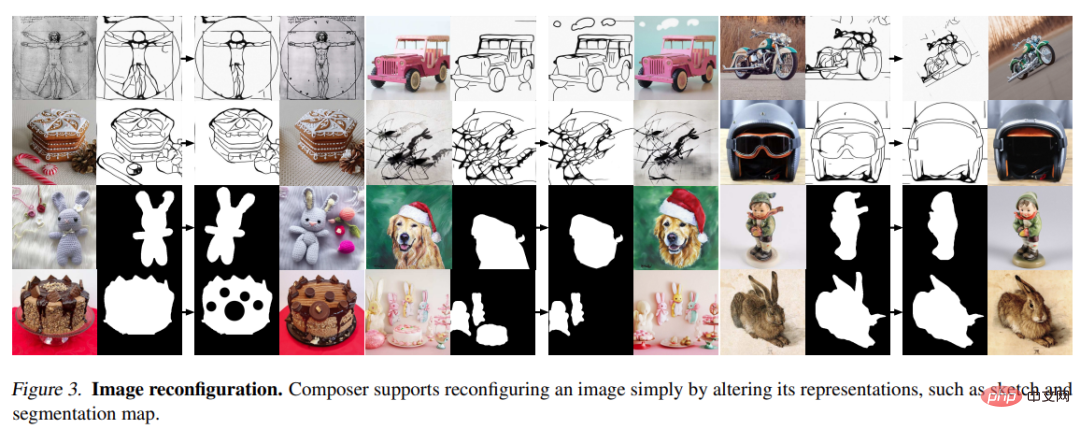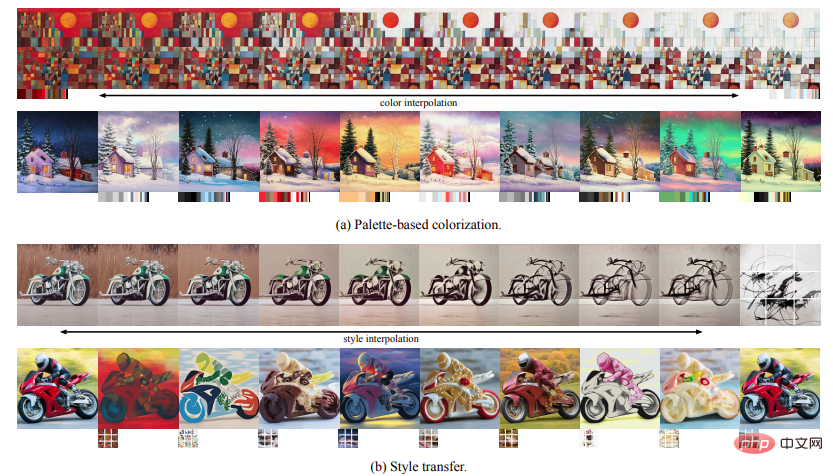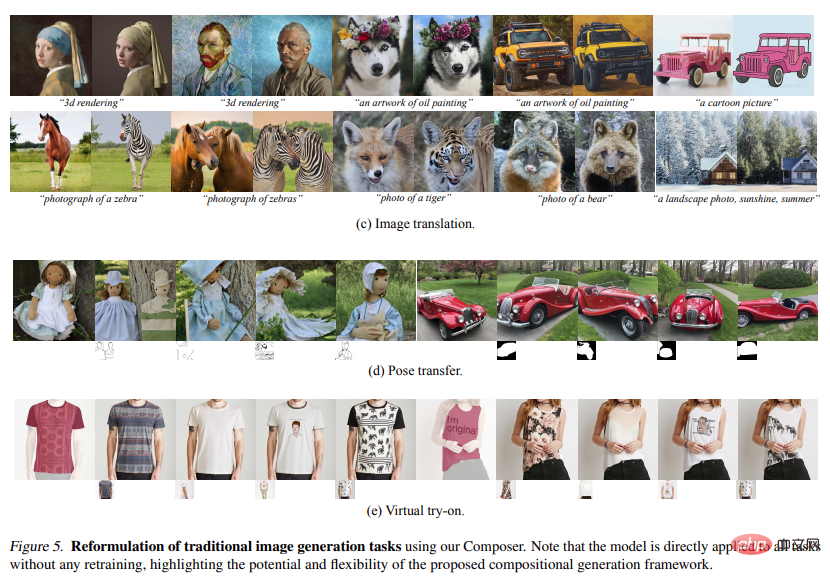 Technology peripherals
Technology peripherals
 AI
AI
 New ideas for AI painting: Domestic open source new model with 5 billion parameters, achieving a leap in synthetic controllability and quality
New ideas for AI painting: Domestic open source new model with 5 billion parameters, achieving a leap in synthetic controllability and quality
New ideas for AI painting: Domestic open source new model with 5 billion parameters, achieving a leap in synthetic controllability and quality

- ##Paper address: https://arxiv.org/pdf/2302.09778v2.pdf
- Project address: https://github.com/damo-vilab/composer
The latest research provides a new generative paradigm that can flexibly control the output image (such as spatial layout and color palette) while maintaining composition quality and model creation. force.
This research takes compositionality as the core idea. It first decomposes the image into representative factors, and then trains a diffusion model conditioned on these factors to reorganize the input. During the inference phase, rich intermediate representations serve as composable elements, providing a huge design space for the creation of customizable content (i.e., exponentially proportional to the number of decomposition factors). It is worth noting that the method named Composer supports various levels of conditions, such as text descriptions as global information, depth maps and sketches as local guidance, color histograms as low-level details, etc.
In addition to improving controllability, the study confirms that Composer can serve as a general framework that facilitates a wide range of classical generation tasks without the need for retraining.
Method
The framework introduced in this article includes a decomposition stage (the image is divided into a set of independent components) and a synthesis stage (the components are recombined using a conditional diffusion model) . Here we first briefly introduce the diffusion model and guidance direction implemented using Composer, and then detail the implementation of image decomposition and synthesis.
2.1. Diffusion model
The diffusion model is a generative model that generates data from Gaussian noise through an iterative denoising process. generate data. Usually a simple mean square error is used as the denoising target:

where x_0 is an optional condition For the training data of c,
is additive Gaussian noise, a_t and σ_t are scalar functions of t, and  is a diffusion model with learnable parameters θ. Classifier-free bootstrapping has been most widely used in recent work for conditional data sampling of diffusion models, where the predicted noise is adjusted by:
is a diffusion model with learnable parameters θ. Classifier-free bootstrapping has been most widely used in recent work for conditional data sampling of diffusion models, where the predicted noise is adjusted by: 

In the formula

Guidance direction: Composer is a diffusion model that can accept a variety of conditions and can achieve various directions without classifier guidance:

c_1 and c_2 are two sets of conditions. Different choices of c_1 and c_2 represent different emphasis on the condition.
The conditions within (c_2 c_1) are emphasized as ω, the conditions within (c_1 c_2) are suppressed as (1−ω), and the guidance weight of the conditions within c1∩c2 is 1.0. . Bidirectional guidance: By using condition c_1 to invert the image x_0 to the underlying x_T, and then using another condition c_2 to sample from x_T, we are able to use Composer to manipulate the image in a disentangled way, where the direction of manipulation is between c_2 and c_1 defined by differences.
Decomposition
Study on decomposing images into decoupled representations that capture various aspects of the image, and describe the task The eight representations used in , these representations are extracted in real time during the training process.
Description (Caption) : Study the direct use of title or description information in image-text training data ( For example, LAION-5B (Schuhmann et al., 2022) ) as an image illustration. Pretrained images can also be leveraged to illustrate the model when annotations are not available. We characterize these titles using sentence and word embeddings extracted from the pre-trained CLIP ViT-L /14@336px (Radford et al., 2021) model.
Semantics and style: Study images extracted using the pre-trained CLIP ViT-L/14@336px model Embeddings are used to characterize the semantics and style of images, similar to unCLIP.
Color: Study the color statistics of images using smoothed CIELab histograms. Quantize the CIELab color space into 11 hue values, 5 saturation and 5 light values, using a smoothing sigma of 10. From experience, this setting works better.
Sketch : Study the application of edge detection models and then use sketch simplification algorithms to extract sketches of images. Sketch captures local details of an image with less semantics.
Instances: Study using the pre-trained YOLOv5 model to apply instance segmentation to images to extract their instance masks. Instance segmentation masks reflect the category and shape information of visual objects.
Depthmap : Study the use of pre-trained monocular depth estimation model to extract the depth map of the image and roughly capture the image Layout.
Intensity: The study introduces the original grayscale image as a representation, forcing the model to learn to deal with the disentangled degree of freedom of color. To introduce randomness, we uniformly sample from a set of predefined RGB channel weights to create grayscale images.
Masking : Study the introduction of image masks to enable Composer to limit image generation or operations to editable areas . A 4-channel representation is used, where the first 3 channels correspond to the masked RGB image and the last channel corresponds to the binary mask.
It should be noted that although this article conducted experiments using the above eight conditions, users can freely customize the conditions using Composer.
Composition
Studies using diffusion models to recombine images from a set of representations. Specifically, the study exploits the GLIDE architecture and modifies its tuning module. The study explores two different mechanisms to adapt models based on representations:
Global conditioning: For global representations including CLIP sentence embeddings, image embeddings, and color palettes, we project and add them to time-step embeddings. Additionally, we project image embeddings and color palettes into eight additional tokens and concatenate them with CLIP word embeddings, which are then used as context for cross-attention in GLIDE, similar to unCLIP. Since conditions are either additive or can be selectively masked in cross-attention, conditions can be dropped directly during training and inference, or new global conditions introduced.
Localization conditioning: For localized representations, including sketches, segmentation masks, depth maps, intensity images, and mask images, we use stacked convolutional layers to project them with noise The latent x_t has uniform-dimensional embeddings with the same spatial size. The sum of these embeddings is then calculated and the result is concatenated to x_t, which is then fed into UNet. Since embeddings are additive, it is easy to adapt missing conditions or incorporate new localized conditions.
Joint training strategy: It is important to design a joint training strategy that enables the model to learn to decode images from various combinations of conditions. The study experimented with several configurations and identified a simple yet effective configuration that uses an independent exit probability of 0.5 for each condition, a probability of 0.1 for removing all conditions, and a probability of 0.1 for keeping all conditions. A special dropout probability of 0.7 is used for intensity images since they contain the vast majority of information about the image and may weaken other conditions during training.
The basic diffusion model produces a 64 × 64 resolution image. To generate high-resolution images, we trained two unconditional diffusion models for upsampling, respectively upsampling images from 64 × 64 to 256 × 256, and from 256 × 256 to 1024 × 1024 resolution. The architecture of the upsampling model is modified from unCLIP, where the use of more channels in low-resolution layers is studied and self-attention blocks are introduced to expand the capacity. An optional prior model is also introduced that generates image embeddings from subtitles. Empirically, prior models can improve the diversity of generated images under specific combinations of conditions.
Experiment
Variation: Using Composer you can create a new image that is similar to a given image, but conditioned on a specific subset of its representation. It's different in some ways. By carefully choosing combinations of different representations, one can flexibly control the range of image changes (Fig. 2a). After incorporating more conditions, the method presented in the study generates a variant of unCLIP that only conditions on the image embedding: using Composer it is possible to create new images that are similar to a given image, but conditional on a specific subset of its representation. Reflection, is different in some ways. By carefully choosing combinations of different representations, one can flexibly control the range of image changes (Fig. 2a). After incorporating more conditions, the proposed method achieves higher reconstruction accuracy than unCLIP, which is only conditioned on image embeddings.






The above is the detailed content of New ideas for AI painting: Domestic open source new model with 5 billion parameters, achieving a leap in synthetic controllability and quality. For more information, please follow other related articles on the PHP Chinese website!

Hot AI Tools

Undresser.AI Undress
AI-powered app for creating realistic nude photos

AI Clothes Remover
Online AI tool for removing clothes from photos.

Undress AI Tool
Undress images for free

Clothoff.io
AI clothes remover

AI Hentai Generator
Generate AI Hentai for free.

Hot Article

Hot Tools

Notepad++7.3.1
Easy-to-use and free code editor

SublimeText3 Chinese version
Chinese version, very easy to use

Zend Studio 13.0.1
Powerful PHP integrated development environment

Dreamweaver CS6
Visual web development tools

SublimeText3 Mac version
God-level code editing software (SublimeText3)

Hot Topics
 1382
1382
 52
52
 Centos shutdown command line
Apr 14, 2025 pm 09:12 PM
Centos shutdown command line
Apr 14, 2025 pm 09:12 PM
The CentOS shutdown command is shutdown, and the syntax is shutdown [Options] Time [Information]. Options include: -h Stop the system immediately; -P Turn off the power after shutdown; -r restart; -t Waiting time. Times can be specified as immediate (now), minutes ( minutes), or a specific time (hh:mm). Added information can be displayed in system messages.
 What are the backup methods for GitLab on CentOS
Apr 14, 2025 pm 05:33 PM
What are the backup methods for GitLab on CentOS
Apr 14, 2025 pm 05:33 PM
Backup and Recovery Policy of GitLab under CentOS System In order to ensure data security and recoverability, GitLab on CentOS provides a variety of backup methods. This article will introduce several common backup methods, configuration parameters and recovery processes in detail to help you establish a complete GitLab backup and recovery strategy. 1. Manual backup Use the gitlab-rakegitlab:backup:create command to execute manual backup. This command backs up key information such as GitLab repository, database, users, user groups, keys, and permissions. The default backup file is stored in the /var/opt/gitlab/backups directory. You can modify /etc/gitlab
 How to check CentOS HDFS configuration
Apr 14, 2025 pm 07:21 PM
How to check CentOS HDFS configuration
Apr 14, 2025 pm 07:21 PM
Complete Guide to Checking HDFS Configuration in CentOS Systems This article will guide you how to effectively check the configuration and running status of HDFS on CentOS systems. The following steps will help you fully understand the setup and operation of HDFS. Verify Hadoop environment variable: First, make sure the Hadoop environment variable is set correctly. In the terminal, execute the following command to verify that Hadoop is installed and configured correctly: hadoopversion Check HDFS configuration file: The core configuration file of HDFS is located in the /etc/hadoop/conf/ directory, where core-site.xml and hdfs-site.xml are crucial. use
 How is the GPU support for PyTorch on CentOS
Apr 14, 2025 pm 06:48 PM
How is the GPU support for PyTorch on CentOS
Apr 14, 2025 pm 06:48 PM
Enable PyTorch GPU acceleration on CentOS system requires the installation of CUDA, cuDNN and GPU versions of PyTorch. The following steps will guide you through the process: CUDA and cuDNN installation determine CUDA version compatibility: Use the nvidia-smi command to view the CUDA version supported by your NVIDIA graphics card. For example, your MX450 graphics card may support CUDA11.1 or higher. Download and install CUDAToolkit: Visit the official website of NVIDIACUDAToolkit and download and install the corresponding version according to the highest CUDA version supported by your graphics card. Install cuDNN library:
 Centos install mysql
Apr 14, 2025 pm 08:09 PM
Centos install mysql
Apr 14, 2025 pm 08:09 PM
Installing MySQL on CentOS involves the following steps: Adding the appropriate MySQL yum source. Execute the yum install mysql-server command to install the MySQL server. Use the mysql_secure_installation command to make security settings, such as setting the root user password. Customize the MySQL configuration file as needed. Tune MySQL parameters and optimize databases for performance.
 Detailed explanation of docker principle
Apr 14, 2025 pm 11:57 PM
Detailed explanation of docker principle
Apr 14, 2025 pm 11:57 PM
Docker uses Linux kernel features to provide an efficient and isolated application running environment. Its working principle is as follows: 1. The mirror is used as a read-only template, which contains everything you need to run the application; 2. The Union File System (UnionFS) stacks multiple file systems, only storing the differences, saving space and speeding up; 3. The daemon manages the mirrors and containers, and the client uses them for interaction; 4. Namespaces and cgroups implement container isolation and resource limitations; 5. Multiple network modes support container interconnection. Only by understanding these core concepts can you better utilize Docker.
 Centos8 restarts ssh
Apr 14, 2025 pm 09:00 PM
Centos8 restarts ssh
Apr 14, 2025 pm 09:00 PM
The command to restart the SSH service is: systemctl restart sshd. Detailed steps: 1. Access the terminal and connect to the server; 2. Enter the command: systemctl restart sshd; 3. Verify the service status: systemctl status sshd.
 How to view GitLab logs under CentOS
Apr 14, 2025 pm 06:18 PM
How to view GitLab logs under CentOS
Apr 14, 2025 pm 06:18 PM
A complete guide to viewing GitLab logs under CentOS system This article will guide you how to view various GitLab logs in CentOS system, including main logs, exception logs, and other related logs. Please note that the log file path may vary depending on the GitLab version and installation method. If the following path does not exist, please check the GitLab installation directory and configuration files. 1. View the main GitLab log Use the following command to view the main log file of the GitLabRails application: Command: sudocat/var/log/gitlab/gitlab-rails/production.log This command will display product



